
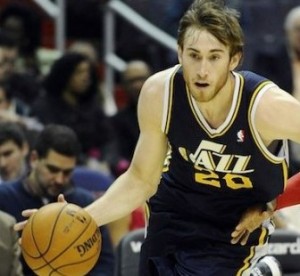 This may become one of the most entertaining seasons in Utah Jazz history. The prospect of Quin Snyder coaching a talented young core led by growing stars Gordon Hayward, Derrick Favors and Rudy Gobert has elicited quiet whispers about making the playoffs.
This may become one of the most entertaining seasons in Utah Jazz history. The prospect of Quin Snyder coaching a talented young core led by growing stars Gordon Hayward, Derrick Favors and Rudy Gobert has elicited quiet whispers about making the playoffs.
Will the Jazz’s supporting cast lift them up or let them down? What is GM Dennis Lindsey doing, and will his risks pay off in the long term?
Basketball enthusiasts should watch the Jazz this season just to see how it all plays out. Here are five things to watch.
1. The offense under Quin Snyder
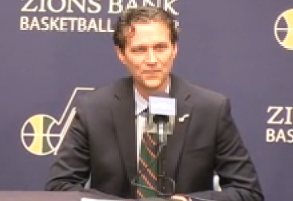 The Utah Jazz have been a model of stability and predictability since relocating from New Orleans. Those qualities have been influenced by strong ownership, sedentary management and a coach-first doctrine. But recent changes at the top of the Jazz’s parent company, the Larry H. Miller Group, have sent shock waves throughout the organization – even down to their NBA team. This tectonic activity has allowed for outside ideas to help foster new growth.
The Utah Jazz have been a model of stability and predictability since relocating from New Orleans. Those qualities have been influenced by strong ownership, sedentary management and a coach-first doctrine. But recent changes at the top of the Jazz’s parent company, the Larry H. Miller Group, have sent shock waves throughout the organization – even down to their NBA team. This tectonic activity has allowed for outside ideas to help foster new growth.
So while the Miller family still owns the Jazz, they are not running the day-to-day basketball business. And the decision-makers are no longer old New York buddies of former GM and top executive Frank Layden. Dennis Lindsey, the current GM, came from outside the Jazz family, working his way up through the front offices of other teams. But most importantly, the Jazz held their first actual coaching search in decades in the summer of 2014 before selecting Quin Snyder.
Snyder was probably the most important Jazz rookie last season. After traveling the world twice over, the former NCAA and D-League coach has an interesting Duke/San Antonio pedigree. Snyder has worked under or alongside Mike Krzyzewski, Gregg Popovich, R.C. Buford, Larry Brown, Doug Collins, Ettore Messina, Mike Budenholzer and Mike Brown.
While Snyder has the background to be an excellent coach, it is his expressive nature that activates the Jazz. His offensive sets use hybrids of core concepts from many of the greatest basketball minds alive, and his playbook is the perfect remedy to the overly cautious, unimaginative and easy-to-defend plays the team defaulted to during the end of the most recent Jazz era.
Last season, the X’s and O’s focused on team defense, with stifling results. This season, we will get to see more of the frantic mania of Snyder’s offensive playbook. Last season’s offense was kept simple, partly because the team was forced to play nine rookies. This season, Utah may make the jump to hyperspace – or at least no longer be one of the worst offenses in the league.
What little we know of the Lindsey/Snyder pairing suggests that the roster and playbook will not lean too heavily on one player. Jazz players will not get the gaudy stats that All-Stars on other teams have. But this is going to be a team to watch, and Snyder will be at the center of all of it.
2. The return of Alec Burks
The best-kept secret on the Jazz is fifth-year combo guard Alec Burks — a player to key an eye on when playing in daily fantasy sports leagues. (Be sure to keep up with the daily posts from our fantasy expert, Kent Williams) The whipping boy of former coach Ty Corbin, Burks played sporadically in his first two seasons. His first career start – somehow at point guard – happened in his third year, when the former lottery pick finally played over 2,000 minutes.
Burks responded with an eye-opening stat line that featured 14.0 points per game on 45.7 percent shooting while getting to the line 4.8 times, all in less than 30 minutes. He wasn’t an ideal shooting guard for previous Jazz teams, but we are no longer living in an era handcuffed to those models.
RELATED: Jazz salaries and analysis
Burks signed a contract extension prior to last season and was on his way to his best campaign under the inventive and creative Snyder, averaging 14/4/3/1 while shooting 38 percent from deep. But a season-ending shoulder injury after just 27 games put him firmly out of sight and out of mind.
And that’s where most people have kept him.
Burks is actually stronger now after having his shoulder surgically repaired, something he should have had done back in college. While it is cliché to state that “Player X is in the best shape of his life,” it may be true for Burks. Additionally, after months of non-contact drills, Burks has a new and improved shot to show for it. The Jazz’s most dangerous and dynamic offensive player seems to have gotten deadlier.
It’s going to be exciting to see how Burks fits into Snyder’s plans.
3. The Big Three
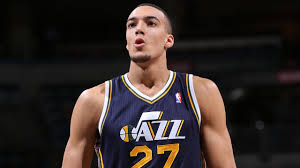 Championship teams are usually built with two ballhandling players and a big man. However, the Jazz are led by one ballhandling wing and two bigs in Gordon Hayward, Derrick Favors and Rudy Gobert.
Championship teams are usually built with two ballhandling players and a big man. However, the Jazz are led by one ballhandling wing and two bigs in Gordon Hayward, Derrick Favors and Rudy Gobert.
The last time a team won an NBA title with a Big Three comprised of a wing and two bigs was the 1980s – several rules changes ago – when the Bird-McHale-Parish Celtics won in 1981, 1984 and 1986. If the Jazz are going to become a championship contender, they are banking on doing it with that precise formula.
With their relative ages and contract status, I don’t think Hayward and Favors can wait around for Australian 20-year-old Dante Exum – out for the season with a torn ACL – to become a star. If this team is going to make the playoffs and make noise there, it is going to be because of this Big Three.
History hasn’t been kind to these groups. The question isn’t how successful this group can be. It is how risky this move is when looked at in the big picture.
4. Jazz counterculture
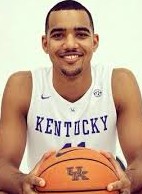 The NBA evolves. It is better to be a trendsetter than to play catch-up. Rules changes combined with cumulative player skill improvements have sped up this evolution, which now favors wing players. Today’s game differs greatly from previous eras, punctuated by ballhandling forwards complemented by big men who draw defenders to the arc by design.
The NBA evolves. It is better to be a trendsetter than to play catch-up. Rules changes combined with cumulative player skill improvements have sped up this evolution, which now favors wing players. Today’s game differs greatly from previous eras, punctuated by ballhandling forwards complemented by big men who draw defenders to the arc by design.
The Golden State Warriors won the title utilizing Draymond Green’s unique talents. The San Antonio Spurs had do-it-all Boris Diaw show us that skills beat size in 2014. And the Miami Heat had Chris Bosh hoisting up corner threes in crunch time on the way to their 2013 title. It is easier to maintain space for your talented ballhandlers if you have a big who can be effective facing up.
Is this a signal or just noise? Whatever may come from this trend, Lindsey seems to be doubling down on the counterculture. The Jazz will start the 6-10 Favors and 7-2 Gobert while bringing 7-3 Tibor Pleiss, 7-foot Jeff Withey, 6-10 Trey Lyles and 6-8 Trevor Booker out of training camp. This is Wasatch Mountain Range size, and none of these guys has a face-up game.
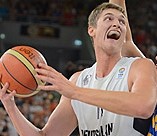 So how will the Jazz survive without a stretch big? Will teams just swallow up any penetration in an already-clogged paint? Will someone among the Jazz’s bigs actually evolve? Gobert, Booker, Pleiss and Lyles do make threes in practice, but I don’t believe they are really ready to add “floor spacer” to their scouting reports. One thing Utah’s bigs do have is a combination of mobility and a willingness to pass.
So how will the Jazz survive without a stretch big? Will teams just swallow up any penetration in an already-clogged paint? Will someone among the Jazz’s bigs actually evolve? Gobert, Booker, Pleiss and Lyles do make threes in practice, but I don’t believe they are really ready to add “floor spacer” to their scouting reports. One thing Utah’s bigs do have is a combination of mobility and a willingness to pass.
Space is not only maintained by the threat of shooting but also by player and ball movement. Few teams passed as many times per game as the Jazz did last season. If Snyder can keep them moving without the ball on offense, they will still be in scoring position via smart cuts or offensive rebounds.
Functionally, this is a matchup problem for both teams, particularly on defense. Utah played great defense after the All-Star break last season, and if the team does super-size this season, opponents might have to contend with two rim protectors all game. If other teams go small, the least mobile Jazz big on the floor will be consistently abused in pick-and-roll situations.
5. Life without Dante
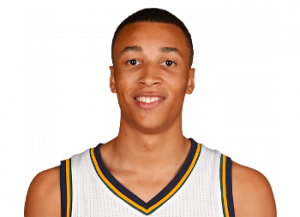 The biggest test for the Jazz this season will be at point guard in the wake of Dante Exum’s torn ACL. In 2013-14, Utah suffered through one of the worst seasons in franchise history, winning just 25 games. Its reward was a top-five draft pick, and the Jazz jumped on the chance to select Exum. The teenager was untested but possessed off-the-charts physical abilities.
The biggest test for the Jazz this season will be at point guard in the wake of Dante Exum’s torn ACL. In 2013-14, Utah suffered through one of the worst seasons in franchise history, winning just 25 games. Its reward was a top-five draft pick, and the Jazz jumped on the chance to select Exum. The teenager was untested but possessed off-the-charts physical abilities.
As a rookie last season, Exum was too timid on offense, despite being a better spot-up shooter than expected. His saving grace was on defense, where his length and athleticism framed a puzzle most opposing guards couldn’t solve. But his impact was not quite what many Jazz fans had hoped.
Will Exum ever become a star? He looked like one in Summer League where he eclipsed draft classmate Marcus Smart. But his injury suffered while playing for Team Australia will cost him a critical developmental year, both individually and with his teammates.
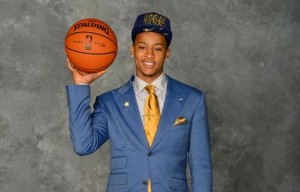 In Exum’s absence, point guard duties fall to fan pariah Trey Burke in a must-succeed season; small sample size All-Star Bryce Cotton, who is on a non-guaranteed deal; and Brazilian rookie Raul Neto. Burke and Neto will battle for the lion’s share of minutes, but none of these three youngsters appear to be the franchise-transforming guard that some believe Exum can be. Some believe Burke is buried treasure, as you can see in this piece reviewing fantasy prospects. As anyone who watches TV can tell you, daily fantasy sports competitions are becoming viable alternatives to online gambling sites like William Hill, 888sports and Betway.
In Exum’s absence, point guard duties fall to fan pariah Trey Burke in a must-succeed season; small sample size All-Star Bryce Cotton, who is on a non-guaranteed deal; and Brazilian rookie Raul Neto. Burke and Neto will battle for the lion’s share of minutes, but none of these three youngsters appear to be the franchise-transforming guard that some believe Exum can be. Some believe Burke is buried treasure, as you can see in this piece reviewing fantasy prospects. As anyone who watches TV can tell you, daily fantasy sports competitions are becoming viable alternatives to online gambling sites like William Hill, 888sports and Betway.
Last season, the Jazz had some of the worst point-guard play in both the NBA and team history. Snyder will be challenged to make things work despite Exum’s injury. A possible solution could be Burks, who received some run at point early in preseason. Ultimately, playing 4-on-5 could be what keeps Utah out of the playoffs if no one steps up.
READ EVERY SEASON PREVIEW WITH OUR TEAM INDEX
Amar Smith is the managing editor of SLCDunk.com, the SB Nation Utah Jazz blog. Follow him at @SLCDUNK on Twitter and like him on Facebook.